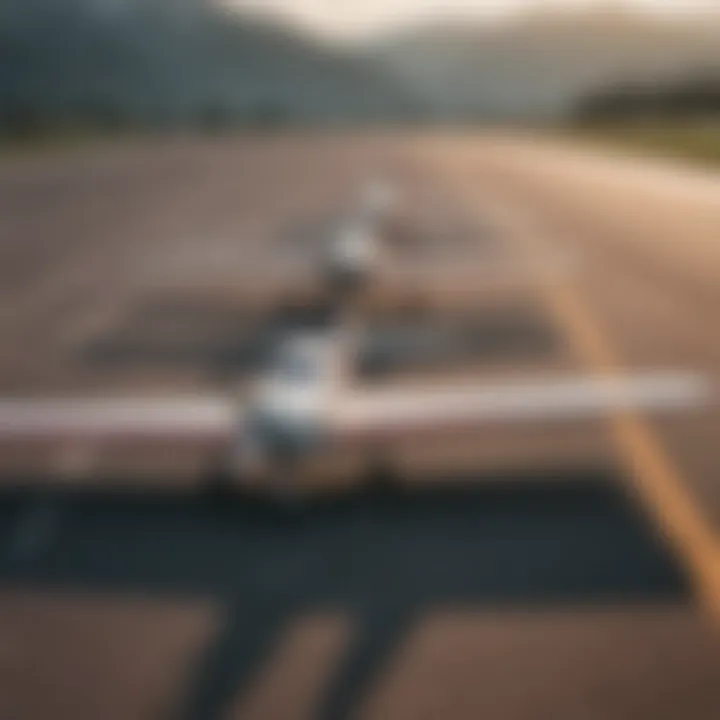Sailplanes: Unveiling Aerodynamics and Innovations


Intro
Sailplanes, commonly referred to as gliders, represent a unique category within the aviation industry. Their design and operation challenge conventional notions of powered flight, focusing instead on the graceful interaction with the earth's atmosphere. This article aims to provide a comprehensive guide on the various aspects of sailplanes—from their aerodynamics and technological advances to their real-world applications.
Understanding sailplanes involves delving into the physics that underpins their flight characteristics. Unlike conventional aircraft that rely heavily on engines for propulsion, sailplanes exploit natural air currents, allowing them to soar with remarkable efficiency.
This exploration is not merely a technical examination; it also highlights the growing significance of sailplanes in the context of sustainable aviation. The potential that sailplanes hold for environmentally friendly flying solutions is a crucial aspect of this discussion.
Key Findings
Sailplanes have evolved significantly through advancements in technology and design with notable implications for various fields. Below are some essential findings derived from the extensive examination of sailplanes:
- Enhanced Aerodynamics: The shape and materials used in sailplane construction such as composite materials significantly reduce drag, allowing for more efficient gliding.
- Advanced Technology: Innovations like flight computers and automated control systems have improved navigation and safety, making flying sailplanes more accessible.
- Diverse Applications: Sailplanes are utilized across multiple domains, including competitive sports, recreational flying, environmental research, and even military applications.
These findings not only highlight the technical mastery involved in sailplane design but also underscore their increasing relevance within the broader aviation sector.
"Sailplanes represent an intersection of artistry and engineering, demonstrating the complexity of flight without the dependency on engines."
Summary of the main results
The article aims to synthesize the understanding of sailplanes by discussing the pivotal role of aerodynamics, advanced materials, and technology advancements. Moreover, it emphasizes the practical applications that range from competition flying to more innovative uses in environmental monitoring and research.
Significance of findings within the scientific community
The research into sailplanes contributes to the larger discourse on sustainable aviation. It provides insights into how traditional flying can be modified to enhance efficiency and minimize environmental impact. The understanding of sailplanes represents not just an academic interest, but a crucial step towards developing sustainable aviation solutions that align with environmental objectives.
Implications of the Research
The implications derived from examining sailplanes extend far beyond aerodynamics and technology.
Applications of findings in real-world scenarios
With insights gleaned from sailplane technology, several real-world applications emerge:
- Sport and Recreation: Gliding sports have gained traction, providing enthusiasts with thrilling experiences while promoting skill development in aviation.
- Scientific Research: Sailplanes facilitate environmental monitoring and data collection, promoting research in aerodynamics and meteorology.
- Military Applications: The stealth and efficient gliding capabilities have garnered interest in military operations, emphasizing their versatility.
Potential impact on future research directions
The exploration of sailplanes lays a foundation for future research in aviation technology. It opens avenues for innovation in lightweight materials, energy-efficient designs, and automatic piloting systems. As environmental concerns continue to shape aviation policies, pursuing sustainable solutions through sailplane technology becomes increasingly pertinent.
Through detailed examination of these aspects, this article seeks to elucidate the broader impacts of sailplanes on the field of aviation and their potential to forge a path toward greener flying solutions.
Preface to Sailplanes
Sailplanes, commonly known as gliders, represent a significant part of aviation that combines physics, engineering, and artistry. Understanding sailplanes is essential for appreciating how they operate in the air without a powered engine. This section sets the stage for the deeper exploration of various aspects of sailplanes, including their design, aerodynamic properties, and innovative technologies.
The importance of studying sailplanes lies in their ability to utilize natural forces for flight. These aircraft glide smoothly through the air, harnessing thermals, ridge lifts, and dynamic soaring techniques. By learning about their basic characteristics and historical context, one gains a clearer picture of how advances in engineering have evolved to enhance performance and safety.
Furthermore, the study of sailplanes is increasingly relevant in the discourse surrounding sustainable flying solutions. As environmental concerns mount, sailplanes emerge as a viable option for reducing the carbon footprint associated with traditional powered flight, thus promoting eco-friendly aviation practices.
Understanding the nuances of sailplanes helps to highlight their engineering marvels and the skill required to operate them effectively.
Definition and Basic Characteristics
A sailplane is a type of aircraft specifically designed for gliding flight. Unlike powered airplanes, sailplanes rely entirely on harnessing the natural currents of air. Their structure is streamlined for efficiency, often featuring long wings that maximize lift while minimizing drag. Sailplanes can be made from various materials, ensuring both durability and weight efficiency.
Key characteristics include:
- Wing Aspect Ratio: Sailplanes typically have high aspect ratios, which helps reduce drag. This design aids in soaring longer distances.
- Control Surfaces: Sophisticated control mechanisms, such as ailerons and elevators, enable precise maneuverability.
- Weight and Balance: Sailplanes are engineered to achieve the right balance, facilitating optimal performance during flight.
History of Sailplane Development
The development of sailplanes has a rich history spanning over a century. The journey began in the early 20th century, when pioneers like Otto Lilienthal experimented with gliders. His successful flights laid foundational principles for future aerodynamic research.
In the 1920s, the term "sailplane" gained popularity, marking the start of organized gliding. The first competitions in Germany showcased advancements in design and piloting techniques. Over the decades, advances in materials and aerodynamics led to soaring performance improvements.
As World War II concluded, sailplane technology entered a new era. With innovations like the use of composites, the construction of modern sailplanes became lighter and more robust. Today, they continue to evolve with cutting-edge technologies, enhancing their role in both recreational and scientific contexts.
The history of sailplanes reflects the interplay between passion for flight and the pursuit of knowledge in aerodynamics, paving the way for the advancements seen today.
Aerodynamics of Sailplanes


The field of aerodynamics is essential in understanding how sailplanes function effectively in the air. Sailplanes rely on the principles of aerodynamics to achieve sustained flight and maximize performance. Aerodynamics focuses on the behavior of air as it interacts with solid objects, and for sailplanes, this leads to critical performance outcomes such as lift, drag, and overall efficiency in flight. By grasping these concepts, engineers improve sailplane designs and pilots enhance their flying techniques.
Fundamental Principles of Aerodynamics
The fundamental principles of aerodynamics revolve around the forces acting on an aircraft in flight. These forces include lift, weight, thrust, and drag. Lift is the upward force generated by the wings, countering the downward pull of weight. It is created due to differences in air pressure above and below the wings, influenced by the shape of the wings and the angle of attack.
- Weight is the force due to gravity acting on the sailplane.
- Thrust is not commonly needed in sailplanes, as they glide rather than using engines to provide forward motion.
- Drag is the air resistance encountered by the sailplane.
Understanding these forces leads to better design choices and flight strategies, enabling pilots to optimize their soaring capabilities.
Lift and Drag in Sailplane Performance
Lift and drag are two pivotal factors determining a sailplane's performance. The relationship between lift and drag is critical for soaring efficiently.
Lift improves as the angle of attack increases but, only up to a certain point before stall occurs. Pilots must manage their angle of attack judiciously while maneuvering in the air to maintain lift without risking a stall.
Drag, on the other hand, correlates directly with the shape and surface of the sailplane. There are two main types of drag:
- Induced Drag: Related to the generation of lift. It increases with higher angles of attack.
- Parasite Drag: Caused by the aircraft's surface, increasing with speed.
Minimizing drag enhances performance, helping sailplanes to glide longer distances.
Role of Wing Design
Wing design is paramount in maximizing a sailplane's aerodynamic efficiency. Several parameters impact wing performance:
- Wing Shape: The specific contour of the wing influences airflow and determines lift and drag characteristics. Wider wings can produce more lift.
- Aspect Ratio: This refers to the ratio of the wingspan to the wing's width. Higher aspect ratios lead to greater efficiency in gliding, as they reduce induced drag.
- Airfoil Section: The cross-sectional shape of the wing, known as the airfoil, affects lift generation. A well-designed airfoil can significantly improve performance at various speeds and angles of attack.
Sailplane engineers continually innovate wing designs to achieve better aerodynamic performance, increasing overall gliding efficiency.
Construction and Materials
The construction and materials used in sailplanes are vital aspects that determine their performance, safety, and longevity. A well-constructed sailplane not only maximizes aerodynamic efficiency but also ensures durability under various flying conditions. Below, we delve into the specific materials used in sailplane construction and the manufacturing techniques that bring these aircraft to life.
Materials Used in Sailplane Construction
Sailplanes are made from a variety of materials, each chosen for specific characteristics like weight, strength, and flexibility. The most common materials used include:
- Fiberglass: Known for its high strength-to-weight ratio, fiberglass is greatly favored for constructing sailplane wings and fuselages. Its lightweight nature allows sailplanes to maintain excellent performance in the air.
- Carbon Fiber: This material is becoming increasingly popular for premium sailplanes. It is exceptionally strong and lightweight. Carbon fiber enhances the rigidity of the structure while keeping the overall weight low, making it ideal for high-performance designs.
- Aluminum: Some older sailplanes utilize aluminum for their structural components. While not as light as modern composites, it offers good durability and is easier to repair.
- Wood: Traditional sailplanes were often made with wood, and while less common today, wood is still used in some designs, especially for training aircraft. It can provide a nostalgic feel and excellent craftsmanship.
Choosing the right materials can make a crucial difference in a sailplane's performance, affecting lift and drag. The use of modern composite materials marks a significant advancement in the field, enabling the design of more efficient and higher-performing sailplanes.
Manufacturing Techniques
The manufacturing techniques used in sailplane construction reflect advancements in technology and materials science. These methods ensure that the sailplane is not only safe to fly but also optimized for performance. Key techniques include:
- Molding: For fiberglass and carbon fiber components, molding techniques such as vacuum bagging and resin infusion are commonly used. These methods allow for precise control over the thickness and integrity of the materials, leading to lightweight and strong structures.
- CNC Machining: Computer Numerical Control (CNC) machines are used to cut and shape components with high precision. This technology allows for complex shapes and designs that were difficult to achieve by hand.
- Hand Layup: Although more labor-intensive, hand layup techniques are still utilized in some custom or small-batch production sailplanes. Skilled craftsmen lay down each layer of material manually, ensuring attention to detail and quality.
- Assembly: The final assembly of sailplane components is a critical step. Techniques vary, but methods often include riveting, bonding, and the use of specialized fasteners to ensure strength and durability in the completed aircraft.
Efficient manufacturing practices not only contribute to the structural integrity of the sailplane but also influence production costs and timelines.
"Modern sailplanes represent a marriage of advanced materials and innovative manufacturing techniques resulting in remarkable performance and reliability."
The continuous improvements in construction materials and manufacturing technologies will undoubtedly shape the future of sailplanes, leading to lighter, stronger, and more efficient aircraft.
Types of Sailplanes
Understanding the various types of sailplanes is critical for grasping their roles in both recreational and competitive flying. Each type appeals to different flying preferences, ensuring an adaptable approach to soaring. These aircraft vary significantly in design, purpose, and performance capabilities, allowing pilots to select based on their experience level and needs.
Standard Class Sailplanes
Standard class sailplanes are designed to meet specific measurement limits, ensuring a level playing field for competitions. These sailplanes usually feature a wingspan of up to fifteen meters. They are celebrated for their balance between performance and simplicity. Pilots find them tolerant and easy to handle, making them suitable for newcomers and seasoned pilots alike.
Key Features:
- Wing Design: The wings of standard class sailplanes are optimized for efficiency, enhancing lift-to-drag ratios.
- Accessibility: This class of sailplane is often more readily available than others, making them a common choice for flight schools.
- Regulated Competition: The design limits encourage innovation within specific bounds, promoting fair competition among pilots.
Open Class Sailplanes
Open class sailplanes break free from strict dimensional regulations, allowing for greater design freedom. This results in larger wings and more advanced performance characteristics. The wingspan often exceeds twenty-five meters, which drastically improves their soaring capabilities. Pilots who seek to fly longer distances or achieve higher altitudes typically favor this category.
Advantages of Open Class Sailplanes:


- Performance: Enhanced aerodynamic designs can lead to superior speed and altitude capabilities compared to standard class options.
- Innovation: The lack of strict regulations allows manufacturers to experiment with advanced materials and technologies.
- Competition Focus: Open class competitions often attract the most skilled pilots, fostering a challenging environment.
Two-Seat Sailplanes
Two-seat sailplanes serve a dual purpose. They act as training platforms for new pilots while also accommodating experienced flyers seeking an instructor or a companion during flights. The design adds weight due to the need for an additional cockpit, which requires careful management of performance characteristics. However, flexibility is a significant advantage of these sailplanes.
Features of Two-Seat Sailplanes:
- Training Utility: They provide a safe environment for learning, allowing instructors to teach fundamentals and advanced techniques simultaneously.
- Stability: Generally, two-seat models are designed for stability, making them user-friendly for novices.
- Shared Experiences: Two-seat options can enhance the enjoyment of flying by allowing shared experiences between friends or family.
By recognizing these types of sailplanes, one gains a clearer understanding of how each variant is tailored to meet specific flying needs. This consideration can guide potential pilots and enthusiasts as they navigate the multifaceted world of sailplane aviation.
Sailplane Performance and Flight Techniques
Sailplane performance and flight techniques are paramount for maximizing the effectiveness and safety of flights. Understanding these elements is essential for both pilots and engineers in developing strategies that enhance gliding experience. Performance relates to the efficiency and capabilities of sailplanes, while techniques encompass the methods pilots use to maneuver and maintain optimal flight conditions.
Understanding Soaring
Soaring refers to the ability of sailplanes to gain altitude from natural rising air currents. This phenomenon occurs when air warms and rises, creating thermals. The pilot's skill in detecting these thermal currents can significantly impact the duration and quality of the flight.
Key aspects of soaring include:
- Thermal identification: Recognizing signs of rising air, such as variations in cloud patterns or bird behavior, can guide pilots towards successful soaring.
- Banking: Adjusting the sailplane's bank angle allows the pilot to exploit lift more effectively.
- Glide Ratio: The glide ratio is crucial. A higher glide ratio affords better performance, permitting the aircraft to cover greater distances without losing altitude rapidly.
Understanding the science behind soaring not only improves flight efficiency but also enables pilots to make strategic decisions based on environmental conditions.
Techniques for Efficient Flight
Achieving efficient flight in sailplanes involves applying specific techniques that complement aerodynamic principles. These techniques are fundamental for pilots aiming to extend their flight duration and cover significant distances.
Several techniques that enhance efficient flight include:
- Speed Management: Maintaining an optimal speed is critical. Flying too fast can increase drag, while flying too slow can prevent effective lift. Pilots should find the balance between these factors.
- Utilizing Wind Patterns: Wind can create favorable conditions for soaring. Pilots should incorporate wind data into their flight strategy, using headwinds for lift and tailwinds for speed.
- Controlled Descent: Pilots often manage their descent by choosing the right moment to transition from soaring to gliding. This control is key to ensuring safety and performance.
- Final Approach Considerations: When preparing to land, pilots must be conscious of their altitude and speed, ensuring a smooth and safe landing.
The applications of these techniques extend to different scenarios, whether in recreational flying, competitions, or operations requiring high precision in maneuvering.
"Understanding performance and flight techniques transforms a novice pilot into an adept navigator in the skies."
Combining these insights about soaring and efficient flight techniques contributes significantly to the overall performance of sailplanes. The careful analysis of these factors is vital for achieving a sophisticated understanding of modern sailplane operations.
Technological Innovations in Sailplanes
Technological innovations play a crucial role in enhancing the capabilities and performance of sailplanes. As these aircraft are increasingly utilized for both recreational and practical applications, the advancements in technology reflect a broader push toward efficiency and sustainability in aviation. Understanding these innovations is vital for anyone interested in the future of sailplane design and operation.
Advancements in Avionics
In recent years, avionics in sailplanes have become significantly more sophisticated. Modern sailplanes often incorporate a variety of advanced electronic systems that improve navigation, communication, and flight safety.
These avionics systems typically include:
- GPS Navigation Systems: Essential for accurate positioning and route planning.
- Flight Computers: Provide critical data on altitude, speed, and thermal activity, enabling pilots to optimize their flight paths.
- Automatic Dependent Surveillance-Broadcast (ADS-B): Enhances situational awareness by transmitting the aircraft's position to air traffic services.
The integration of these technologies not only increases flight safety but also enhances the overall flying experience. With accurate data at their fingertips, pilots can make more informed decisions during flight.
Integration of Composite Materials
The evolution of materials used in sailplane construction has also progressed rapidly. Composite materials, such as carbon fiber and fiberglass, are now commonly used in sailplane design. They provide several advantages over traditional materials like aluminum and wood.
Key benefits of using composite materials in sailplanes include:
- Reduced Weight: Composites are lighter, which improves overall performance and maneuverability.
- Increased Strength: These materials are not only strong but also flexible, which enhances the durability of sailplanes under various flight conditions.
- Better Aerodynamic Properties: The smooth surface finish of composites reduces drag and contributes to better efficiency during flight.
The choice of materials can greatly affect the performance of sailplanes. As manufacturers continue to explore new composite technologies, the performance envelope for these aircraft is likely to expand, making them even more versatile in various applications.
Applications of Sailplanes
The applications of sailplanes extend far beyond sheer recreational enjoyment. This essential aspect of the discourse highlights how sailplanes are utilized in various fields, bringing a unique set of benefits and challenges. Understanding these applications provides insights into how sailplanes can contribute to technology and society, emphasizing their role in sustainable aviation.
Recreational and Competitive Flying
Sailplanes serve as a popular choice for recreational flying among enthusiasts. This activity not only fosters a sense of adventure but also promotes skill development among pilots. The tranquility of soaring through the sky, coupled with the challenge of navigation and flight management, attracts numerous individuals to the sport.


Competitive flying is another dynamic area linked to sailplanes. Events like the Gliding World Championships encourage pilots to test their skills under stringent conditions. Participants must adeptly utilize thermals and winds to cover significant distances in the shortest time possible. The competition not only bolsters skillful flying but also encourages technological innovations. The strategies developed during competitions often lead to advancements in sailplane design and performance.
Transport and Cargo Operations
While sailplanes are primarily perceived as recreational aircraft, their applications extend into the realm of transport and cargo operations. Utilizing sailplanes for light cargo transport offers distinct advantages, including reduced cost and lower environmental impact. For short distances, sailplanes can efficiently deliver goods without relying solely on fuel.
In more remote locations, where traditional transport might be limited, sailplanes can become vital. Their ability to glide without extensive takeoff space allows them to land in areas where conventional aircraft might struggle. Thus, they present a feasible option for transporting goods in challenging terrains, making them a valuable tool in logistical planning.
Scientific Research and Environmental Monitoring
In recent years, scientists have recognized the potential of sailplanes for various research applications. Their capacity for extended flight duration without fuel makes them suitable for gathering environmental data. For example, sailplanes can collect information about atmospheric conditions, bird migration patterns, or pollution levels.
Moreover, their quiet nature enables scientists to monitor wildlife in ways that do not disturb natural habitats. Researchers can deploy sailplanes equipped with sensors and cameras to observe ecosystems or collect geographical data without human interference. As a result, sailplanes play a critical role in advancing understanding within the field of ecology.
Sailplane Piloting and Training
Sailplane piloting and training is the cornerstone of safe and effective gliding. The proficiency of pilots directly influences the safety and enjoyment of sailplane flying. Training ensures that pilots understand the unique aerodynamic principles and operating characteristics of sailplanes, which differ significantly from other aircraft. The importance of this training cannot be overstated. Proper education allows pilots to make informed decisions in various flying conditions, maximizing both performance and safety.
Pilot Training Programs
Pilot training programs for sailplanes typically offer a structured curriculum. Various organizations and clubs provide these programs that combine both theoretical and practical knowledge. The training often begins with basic concepts in aerodynamics, leading to more advanced topics like thermals and gliding techniques. Pilot trainees learn the following during these programs:
- Ground School: This phase covers the fundamental aspects of aviation, including meteorology, airspace regulations, and aircraft systems.
- Flight Instruction: Under the guidance of qualified instructors, trainees get hands-on experience. This starts with dual flights, where the instructor controls the sailplane. Eventually, the student progresses to solo flights.
- Skill Refinement: After obtaining initial solo status, pilots further refine their skills. They may participate in cross-country flying and learn advanced techniques for soaring in different weather conditions.
- Safety Practices: Emphasis is placed on safety protocols and emergency procedures. Pilots must be prepared for unexpected situations.
Pilot training is not only essential for safety, but also enhances the overall enjoyment of flying. Confident and informed pilots are better equipped to explore the skies, making them more engaged and capable.
Regulatory Requirements for Pilots
Regulatory requirements for sailplane pilots vary by region but generally ensure a standard of competency and safety. In many countries, obtaining a glider pilot license mandates meeting several criteria:
- Medical Certification: Pilots must pass a medical examination to confirm their suitability for flight duties.
- Knowledge Exams: Many regions require prospective pilots to pass written examinations covering aviation rules and principles.
- Flight Hours: There is often a minimum flight hour requirement to ensure pilots have adequate experience.
- Check Rides: A check ride with an examiner ensures that the pilot can demonstrate their skills and knowledge effectively.
These regulatory requirements not only standardize the training process but also foster a culture of safety and responsibility within the community of sailplane pilots. Staying informed about these regulations is crucial for anyone pursuing a career or hobby in sailplane flying.
"The quality of training provided to sailplane pilots significantly impacts their capacity to navigate and enjoy the complexities of soaring flight."
In summary, piloting and training in sailplanes involves structured programs and adherence to regulatory requirements. Both elements play a vital role in shaping skilled pilots. This knowledge enhances the safety and pleasure derived from the sport while maintaining the integrity of the aviation community.
Future of Sailplanes
As the world increasingly prioritizes environmental considerations and innovative technology, the future of sailplanes becomes ever more compelling. This section elaborates on how advancements in design and operating efficiencies are aligned with sustainable aviation goals, while also exploring emerging technologies shaping this domain.
Potential for Environmental Sustainability
Sailplanes inherently offer advantages in terms of environmental impact compared to traditional powered aircraft. Their ability to glide on natural lift means they can fly long distances without consuming fossil fuels. This characteristic significantly reduces carbon emissions, positioning sailplanes as a more eco-friendly option in aviation.
Recent studies have suggested that increasing the use of sailplanes can contribute to a broader shift in aviation practices aimed at sustainability. This encompasses both recreational flying and commercial applications where reduced emissions are especially desirable. Furthermore, the integration of alternative energy sources, such as solar energy, presents novel opportunities for expanding the operational range of sailplanes. Solar cells could potentially be incorporated into sailplane structures, providing supplementary power without detracting from their aerodynamic efficiency.
Key points in considering the potential for sustainability include:
- Reduced carbon footprint compared to powered aircraft.
- Utilization of renewable energy sources like solar power.
- Decreased noise pollution, making sailplanes more suitable for flight near populated áreas.
Overall, embracing sailplanes contributes positively to the aviation industry's goals for reducing climate impact.
Emerging Trends in Technology
Technological advancements continue to transform the landscape of sailplane design and function. As aerospace engineering evolves, several trends are gaining prominence, marking a shift towards greater efficiency and performance.
- Smart Avionics: Modern sailplanes are increasingly equipped with advanced avionics, providing pilots with intuitive navigation aids and performance metrics that enhance the soaring experience. Systems for analyzing lift and thermal currents in real-time aid pilots in optimizing their flight paths.
- Composite Materials: The use of composite materials has revolutionized sailplane construction. Lightweight yet strong, these materials improve the aircraft's performance while also extending its lifespan. This trend aligns with the goal of reducing overall aircraft weight, essential for enhancing fuel efficiency and reducing emissions.
- Automated Features: An emerging trend involves increasing automation in sailplane controls. This includes the development of autopilot systems that allow pilots to focus on navigation without the constant need for manual adjustments. Safety and operational efficiency are enhanced through these innovations.
"The future of sailplanes is deeply intertwined with advancements in technology and an urgent need for sustainability in aviation."
In summary, as we look towards the horizon, the trajectory of sailplanes points to a synthesis of environmental stewardship and technological innovation. Continued research and development will be critical in realizing the full potential of these aircraft, ensuring they not only contribute to a greener future but also redefine what is possible in the skies.
Finale
In summarizing the discussion on sailplanes, it becomes clear that these aircraft are not merely instruments of sport but embody a significant area of technological advancement and aerial exploration. Sailplanes showcase exceptional engineering feats that utilize aerodynamics and materials science effectively. Their design must accommodate the intricate balance between lift and drag, crucial for efficient flight. Technological innovations like better avionics and composite materials have significantly improved their performance and fuel efficiency.
Summary of Key Points
- Aerodynamics: The functioning of sailplanes heavily relies on principles of aerodynamics, including the management of lift and drag.
- Construction and Materials: The choice of materials and manufacturing techniques has evolved, enhancing structural integrity and reducing weight.
- Performance: Different types of sailplanes cater to various flying styles, from competitive sports to recreational use.
- Technological Advancements: Innovations focus on avionics and composite materials to improve overall efficiency.
- Applications: Beyond leisure, sailplanes serve in scientific research and cargo transport, expanding their utility in modern aviation.
- Future Prospects: With continuous developments, sailplanes hold potential for advancing environmental sustainability in flight.
The Ongoing Relevance of Sailplanes
Sailplanes maintain their relevance in various applications and stand at the intersection of tradition and innovation. Their contribution extends beyond sport into realms like education and environmental science. They provide an accessible way for individuals to understand the principles of flight while promoting skills in aerodynamics and navigation.
Sailplanes can be seen as a model for future aviation solutions. As the world increasingly turns to sustainable technologies, their low-energy consumption and reliance on natural events for lift highlight a promising pathway. This focus on efficiency plays an essential role in developing new aviation practices. The future of sailing offers a fascinating look at how we can blend heritage with the needs of tomorrow, making sailplanes relevant for decades to come.







